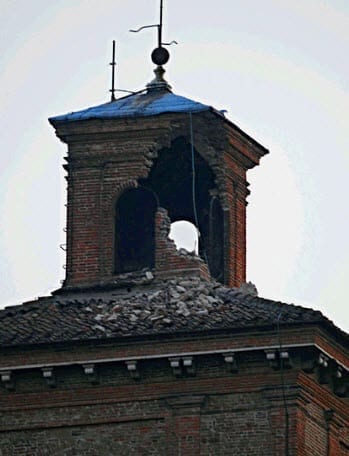
According to catastrophe modeling firm AIR Worldwide, in the early morning hours (2:03 UTC) of Sunday, May 20, an earthquake struck the Emilia-Romagna region of northern Italy. The US Geological Survey issued a moment magnitude estimate of 6.0 for the event. Italy’s National Institute of Geophysics and Volcanology (INGV) reported a local magnitude of 5.9. Focal depth is estimated at between 6.3 km (by INGV) and 10 km (USGS), making this a shallow event. Indeed, the shallowness of today’s earthquake will likely exacerbate the damage. The largest aftershock reported so far was a magnitude 5.1 earthquake (M4.9, according to the INGV) that occurred one hour after the main shock. Note, however, that these seismic parameters may yet be revised.
“The earthquake was the strongest to occur in Italy since the magnitude 6.3 L’Aquila earthquake that struck central Italy in 2009,” said Dr. Mehrdad Mahdyiar, senior director of earthquake research at AIR Worldwide. Today’s event occurred in an area of generally low seismicity and using currently available information, early indications are that insured losses will not be significant given the low residential take-up rates and the relatively rural nature of the epicentral region.”
According to the INGV, there are no historical records of earthquakes of this magnitude within a radius of about 30-40 km.
The epicenter of the earthquake was located 4 km east northeast of the town of Camposanto (est. pop. 3,200 as of 2010) and 5 km southeast of San Felice sul Panaro (est. pop. 10,500). However, the ground motion was felt in towns and villages throughout the Emilia Romagna region. While tremors were felt in Modena and Bologna, the region’s capital, no significant damage has been reported in either city.
Dr. Mahdyiar continued, “The tectonic evolution of Italy is shaped by the interactions between the African and Eurasian plates, which are currently converging at a rate of about 10 mm per year along a north-south direction. This seismotectonic setting is greatly complicated by the presence of the Adria microplate, i.e., a promontory of Africa toward Eurasia, which causes active compression along its borders, and the growth of the broad Adria-verging outer and inner thrust systems, said The seismicity along the Apennines, the region where today’s earthquake occurred, reflects the complex seismotectonic of the plate convergence and the retreats of the SW-subducting Ionian slab. In this framework, the Padano-Adriatic margin of the Apennines is characterized by compressional earthquakes that are generated by the buried active frontal thrust of the Adria-verging chain. It is at the northern end of the Apennine chain compression that today’s earthquake occurred.”
“The reinforced concrete construction that dominates newer buildings in the region fared relatively well, although shear cracking in some walls is evident. It is possible that some structural damage may have occurred to these buildings, depending on the degree of enforcement of existing seismic design code. The development of the seismic zonation in Italy throughout the last decades has led to levels of seismic resistance that vary according to region and building’s age. It should be noted that earthquake take-up rates for residential properties in the region are low; hence damage to commercial properties will likely drive the insured losses.”
According to AIR, the worst of the damage occurred to unreinforced masonry (URM) buildings, many of which were of historical significance to the region. The 14th century Estense Castle in San Felice sul Panaro was severely damaged and parts of another medieval castle (Rocche) in the town of Finale Emelia collapsed. Historical churches in several towns were also badly damaged. In Sant Agostino, a ceramics factory—apparently of light metal construction—collapsed. Sant Agostino’s URM town hall also suffered major damage. A metal silo at a factory in the town of Burana lay twisted on the ground.
AIR is continuing to monitor the situation and will provide updates if warranted.
